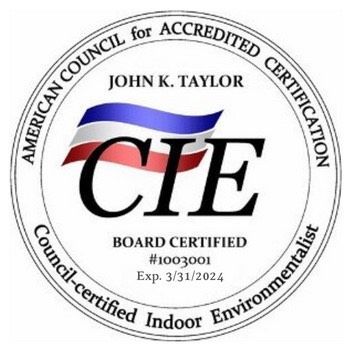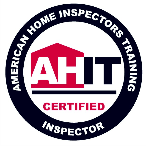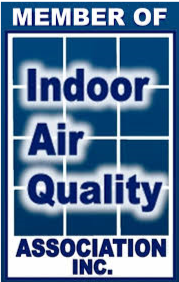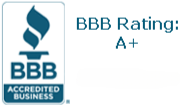Mold Inspection and Testing FAQs
Mold can be a serious health hazard, and if you suspect its presence in your home or office, you should consider mold testing. Here's what you need to know:
-
What is mold testing?
Mold testing involves collecting air or surface samples from your home or building to determine if there is mold growth or spores present. The samples are analyzed in a laboratory to identify the type of mold and its concentration.
-
Why should I get mold testing done?
Mold testing can help identify the extent of a mold problem and determine the best course of action (i.e., the appropriate remediation measures) to take. By knowing the type of mold present, you can take steps to reduce exposure to it and prevent it from recurring.
-
How is mold testing performed?
Mold testing can be done using specialized equipment such as air sampling pumps, swabs, or tape lifts. Samples are collected and then analyzed in a laboratory to identify the type and concentration of mold present.
-
What are the different types of mold tests?
There are three common types of mold tests: air sampling, surface sampling, and bulk sampling. Air sampling tests the concentration of mold spores in the air, while surface sampling tests for the presence of mold on surfaces. Bulk sampling involves collecting pieces of material, such as drywall or insulation, for laboratory analysis.
-
How accurate are mold tests?
The accuracy of mold tests depends on the sampling method used and the laboratory analyzing the samples. It is important to choose a reputable testing service to ensure accurate and reliable results.
-
How long does it take to get mold test results?
The turnaround time for mold test results can vary depending on the testing service used and the type of samples collected. In general, results can be available within a few days to a week.
-
Can I do mold testing myself?
DIY mold testing kits are available, but it is generally recommended to hire a professional mold testing service for accurate and reliable results.
-
How much does mold testing cost?
The cost of mold testing varies on a case-by-case basis depending on the size of the property, the type of testing done, and the location.
-
What should I do if mold is found during testing?
If mold is found during testing, it's important to take immediate action to address the issue. This may include hiring a professional mold remediation service to remove the mold and address the underlying cause of the growth.
-
How can I prevent mold growth in my home or office?
To prevent mold growth, it's important to control moisture levels by addressing any leaks or water damage promptly, ensuring proper ventilation, and using dehumidifiers in humid areas. Regular cleaning and maintenance can also help prevent mold growth.
Mold Remediation FAQs
Here you'll find answers to common questions about mold remediation and what to expect when working with a professional mold remediation service.
-
What is mold remediation?
Mold remediation is the process of safely removing mold and addressing the underlying causes of mold growth in your home or building. This involves identifying and fixing the source of moisture, containing the affected area, removing mold-infested materials, and cleaning and disinfecting the area to prevent future growth.
-
When should I consider mold remediation?
If you suspect mold growth in your home or building, or if you've had a water damage event such as a flood or leak, it's important to consider mold remediation. Mold can cause serious health problems, damage your property, and lower the air quality in your home or building.
-
How is mold remediation performed?
Mold remediation typically involves a thorough inspection of the affected area to determine the extent of the mold growth and the underlying cause. Then, a professional mold remediation service will create a customized plan to safely and effectively remove the mold and prevent future growth.
-
Can I do mold remediation myself?
While DIY mold remediation is possible, it's generally not recommended. Mold can be dangerous to handle and requires specialized equipment and expertise to properly remove and prevent future growth. Hiring a professional mold remediation service can ensure the safety and effectiveness of the remediation process.
-
What should I look for in a mold remediation service?
When choosing a mold remediation service, it's important to look for a licensed, insured, and experienced company that follows industry-standard techniques and safety protocols. They should also provide transparent pricing and offer a warranty on their work.
-
How long does mold remediation take?
The length of time it takes to complete mold remediation can vary depending on the extent of the mold growth and the size of the affected area. While most mold remediations only take 1-2 days, more complex cases can take up to a couple weeks.
-
How much does mold remediation cost?
The cost of mold remediation can vary depending on the extent of the mold growth and the size of the affected area. On average, mold remediation can cost anywhere from a few thousand to tens of thousands of dollars. However, the cost of remediation is much lower than the cost of property damage and health issues caused by mold.
-
Is mold remediation covered by insurance?
Mold remediation may be covered by insurance if the mold growth is a result of a covered water damage event. It's important to check your insurance policy and work with your insurance provider to determine coverage.
-
What should I do after mold remediation is complete?
After mold remediation is complete, it's important to address the underlying cause of mold growth to prevent future infestations. This may include fixing leaks or addressing ventilation issues. Regular inspections and maintenance can help prevent mold growth from returning.
-
Can mold return after remediation?
While mold remediation can effectively remove mold, it's possible for mold to return if the underlying cause of mold growth isn't addressed. Regular inspections, proper maintenance, and immediately fixing the source of mold contamination can help prevent mold growth from returning.
General Mold FAQs for Home & Building Owners
Mold is a type of fungus that thrives in moist environments and feeds on organic matter. While mold plays a crucial role in decomposing and recycling nutrients in the ecosystem, it can be harmful when present in high concentrations indoors.
-
What is mold and should I be concerned about it in my home or building?
Mold is a type of fungus that can be found both indoors and outdoors. It can grow on any surface that provides food and moisture, including paper, wood, and leaves. Mold colonies can release tiny fragments into the air, which can cause indoor air pollution and lead to health problems like allergies or respiratory issues.
If you can see or smell mold inside your home or building, it's time to take action and eliminate the source of excess moisture, as well as clean and remove the mold. It's best to consult a professional before attempting to clean the mold yourself.
-
What are the common symptoms of mold exposure?
Mold can cause health issues through inflammation, allergy, or infection. Allergic reactions, often referred to as hay fever, are the most common health problems caused by mold exposure. Common symptoms of mold exposure include:
- Eye irritation
- Dry cough and throat irritation
- Skin rashes and/or hives
- Respiratory problems such as wheezing, difficulty breathing, and shortness of breath
- Nasal and sinus congestion
- Headaches and neurological issues such as memory problems and mood swings
- Nosebleeds, body aches and pains, and fevers.
-
How am I exposed to indoor mold?
Everyone is exposed to some degree of mold on a daily basis without significant harm. However, mold exposure can be dangerous when mold spores are present in high numbers and inhaled. This typically occurs when there is active mold growth within homes and buildings where people live or work. People can also be exposed to mold through contact with contaminated materials or consumption of contaminated food.
-
What causes mold growth and how can it be prevented?
Common causes of mold growth include high humidity levels, water damage from leaks or floods, poor ventilation, and lack of maintenance. To prevent mold growth, it's important to control moisture levels by addressing any leaks or water damage promptly, ensuring proper ventilation, and using dehumidifiers in humid areas. Regular cleaning and maintenance can also help prevent mold growth.
-
What should I do if I suspect mold growth in my home or building?
If you suspect mold growth, it's important to have a professional inspection and testing done to determine the extent of the mold contamination and the appropriate remediation measures to take.
-
Can mold be completely removed?
While mold can be removed, it's often difficult to remove it completely, especially if the underlying cause of mold growth isn't addressed. Proper remediation and prevention measures can help to ensure that mold growth is kept to a minimum.
-
What should I do if I've been exposed to mold?
If you've been exposed to mold and are experiencing symptoms, it's important to seek medical attention. You should also have the mold contamination addressed to prevent further exposure.
Mold and Your Health
Mold is a silent hazard that can have serious impacts on your health. Exposure to indoor mold can lead to a range of symptoms such as headaches, dizziness, respiratory problems, chronic sinusitis, and even hives.
-
Where does mold grow indoors?
Mold thrives in moist environments, making it a common problem in many homes and buildings. Leaks in roofs, windows, or pipes, as well as areas affected by flooding, are common hotspots for mold growth. Mold also loves to grow on paper and wood products, cardboard, ceiling tiles, and ductwork. Dust, paints, wallpaper, insulation, drywall, carpet, fabric, and upholstery can also provide the perfect conditions for mold to flourish.
The most common indoor molds are Cladosporium, Penicillium, and Aspergillus.
-
How does mold get inside your home or building?
Mold can enter your home through open doors and windows, vents, and your heating and air conditioning system. It can also be carried indoors on clothing, shoes, and pets. When mold spores land on moist surfaces like leaky roofs, pipes, or flooded areas, mold can quickly grow and spread.
-
How do you first identify a mold problem?
Musty odors are a tell-tale sign of mold. You may also see visible mold growth or experience health symptoms such as headaches, dizziness, respiratory problems, and more.
-
How does mold affect your health?
The Centers for Disease Control and Prevention (CDC) states that exposure to moldy environments can have varying effects on health. Some individuals may be sensitive to molds and experience symptoms such as stuffy nose, wheezing, itchy eyes, or skin. People with allergies to molds or asthma may have more intense reactions. Prolonged exposure to large amounts of mold in occupational settings can cause severe reactions such as fever and shortness of breath.
Studies have linked indoor mold exposure to upper respiratory tract symptoms, such as coughing and wheezing in healthy people and more severe asthma symptoms in people with asthma. A potential link between early mold exposure and the development of asthma in children has also been suggested.
While a connection between mold and memory loss, lethargy, and acute idiopathic pulmonary hemorrhage has not been proven, further research is needed. Allergies to mold can be tested by some physicians, but there are no clinically proven tests to determine the source or timing of a mold exposure.
Protect Your Health with Expert Indoor Air Quality Services
Don't let mold or other indoor air pollutants impact your health and well-being. Contact us today to learn how our indoor environmental solutions can help you breathe easier and live healthier. Fill out the form below or call us at (877) 932-4652.
We will get back to you as soon as possible
Please try again later








